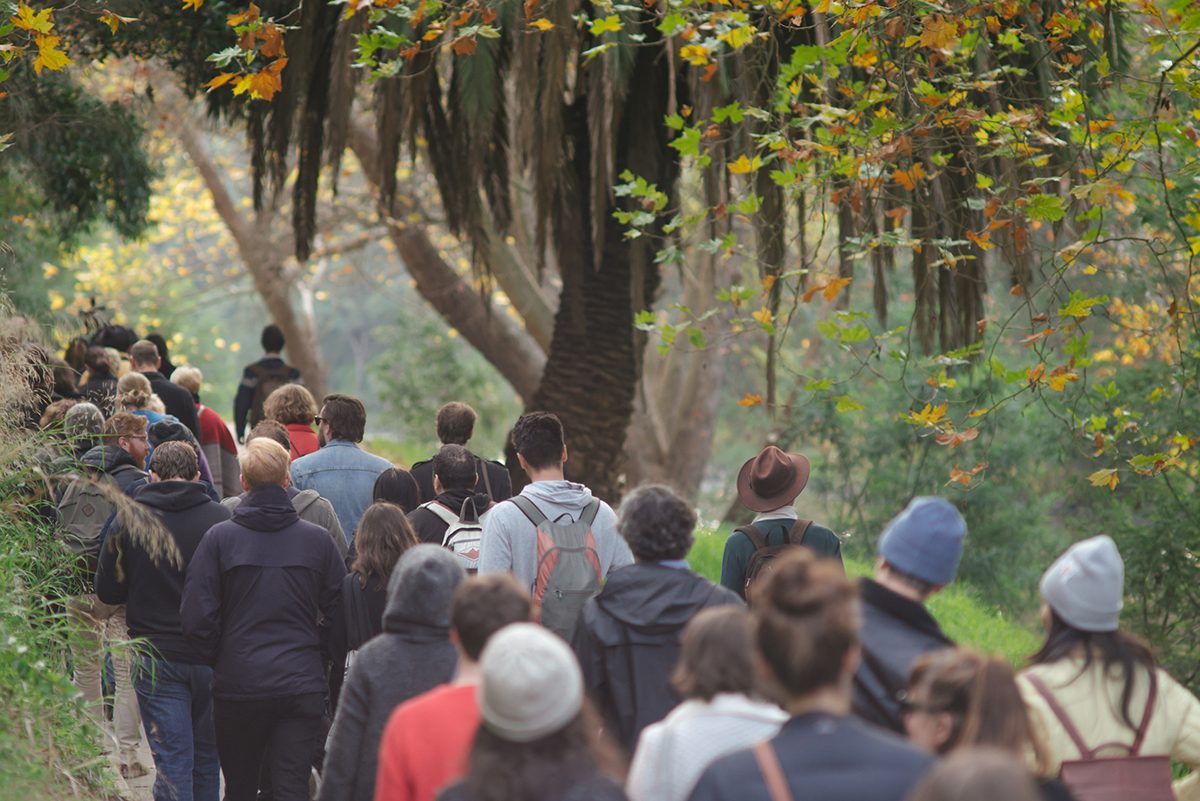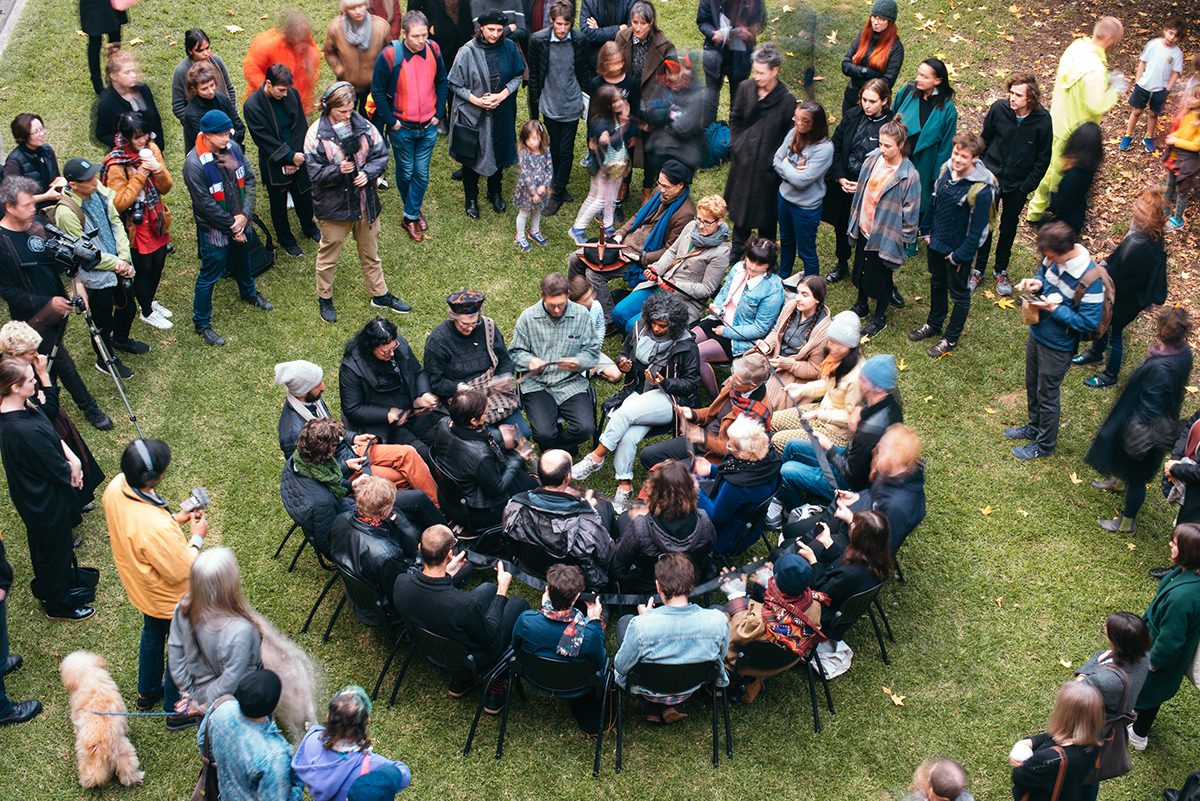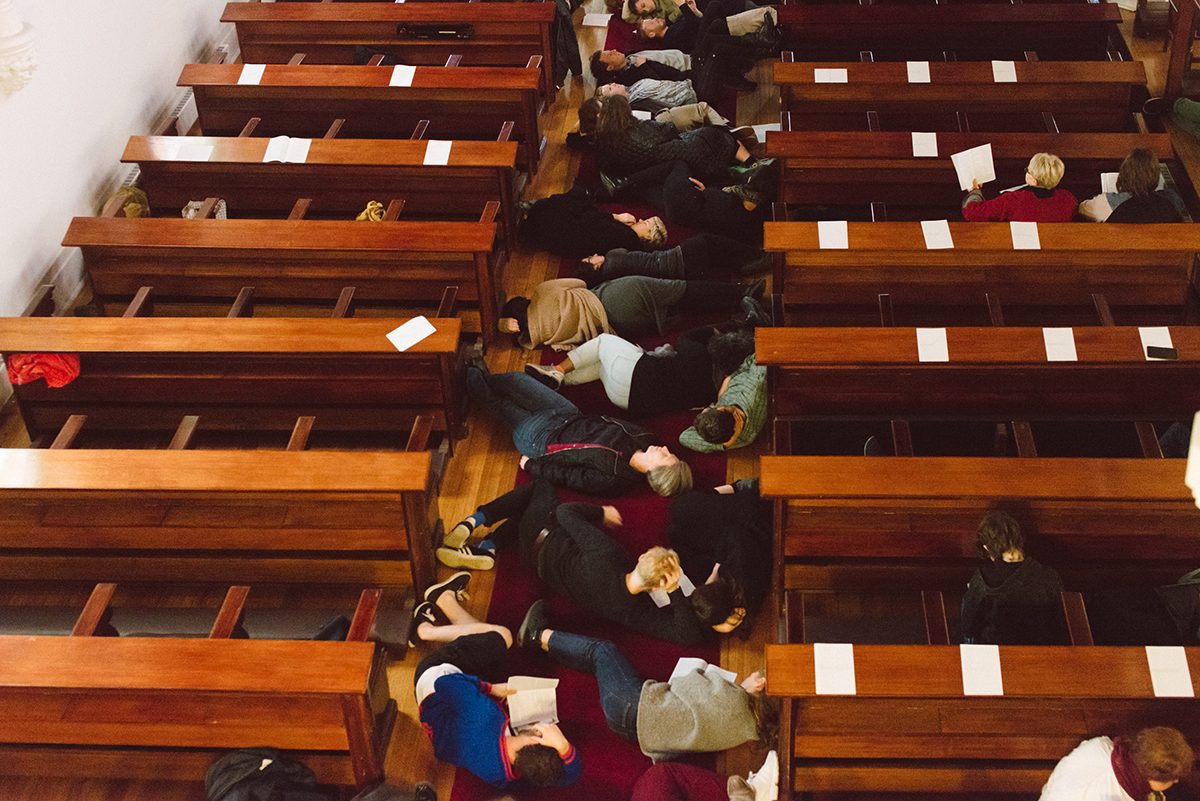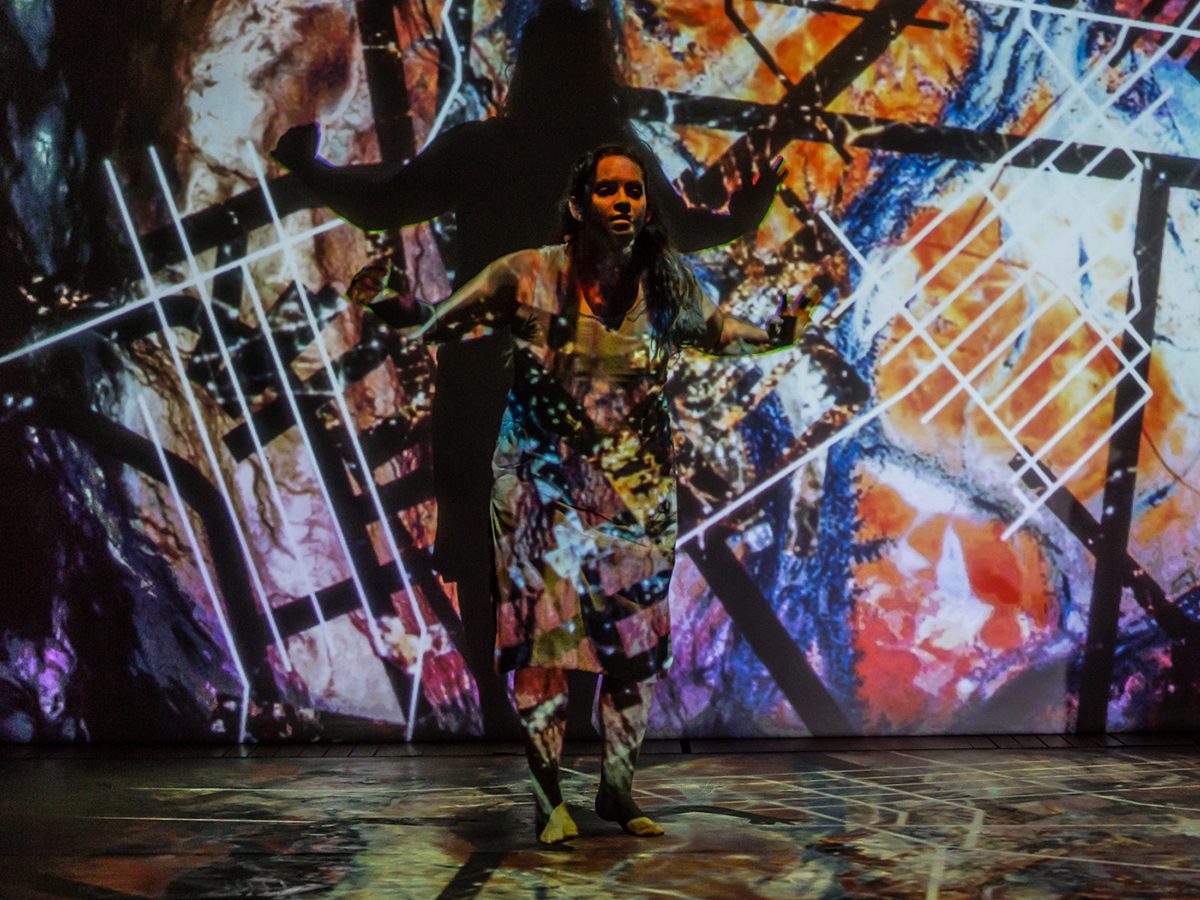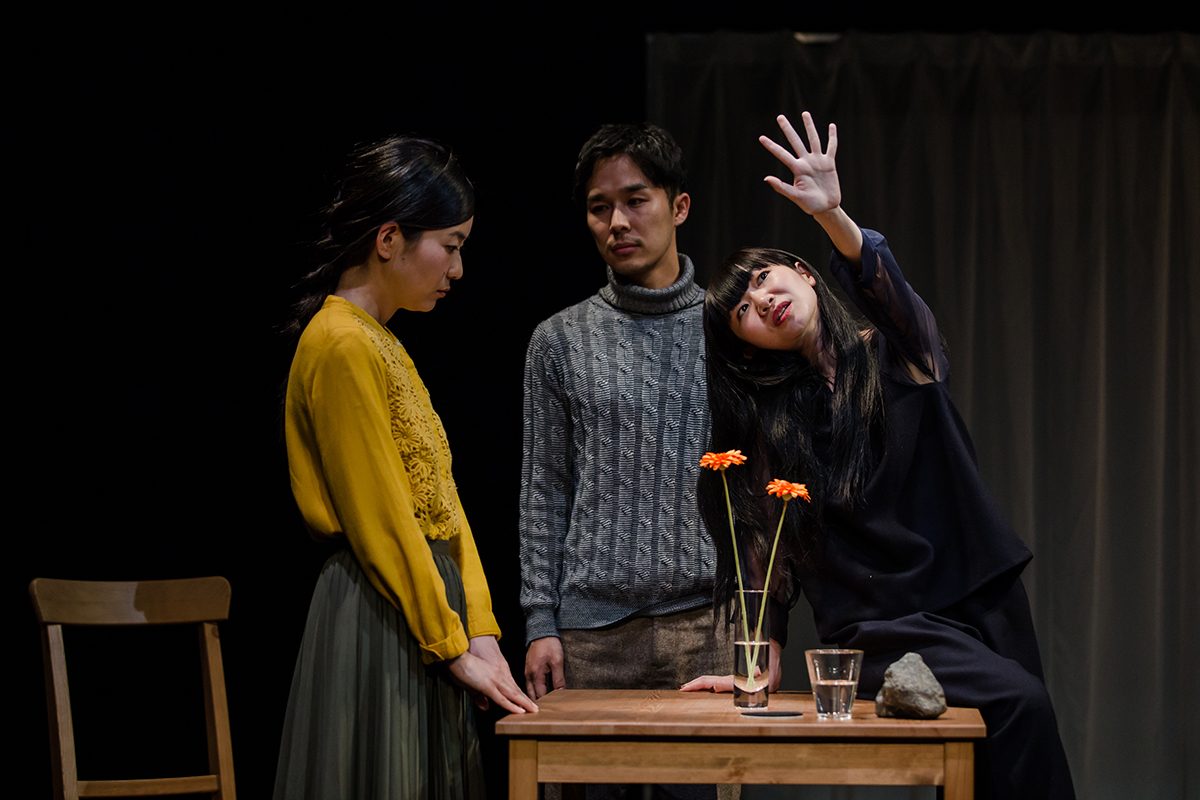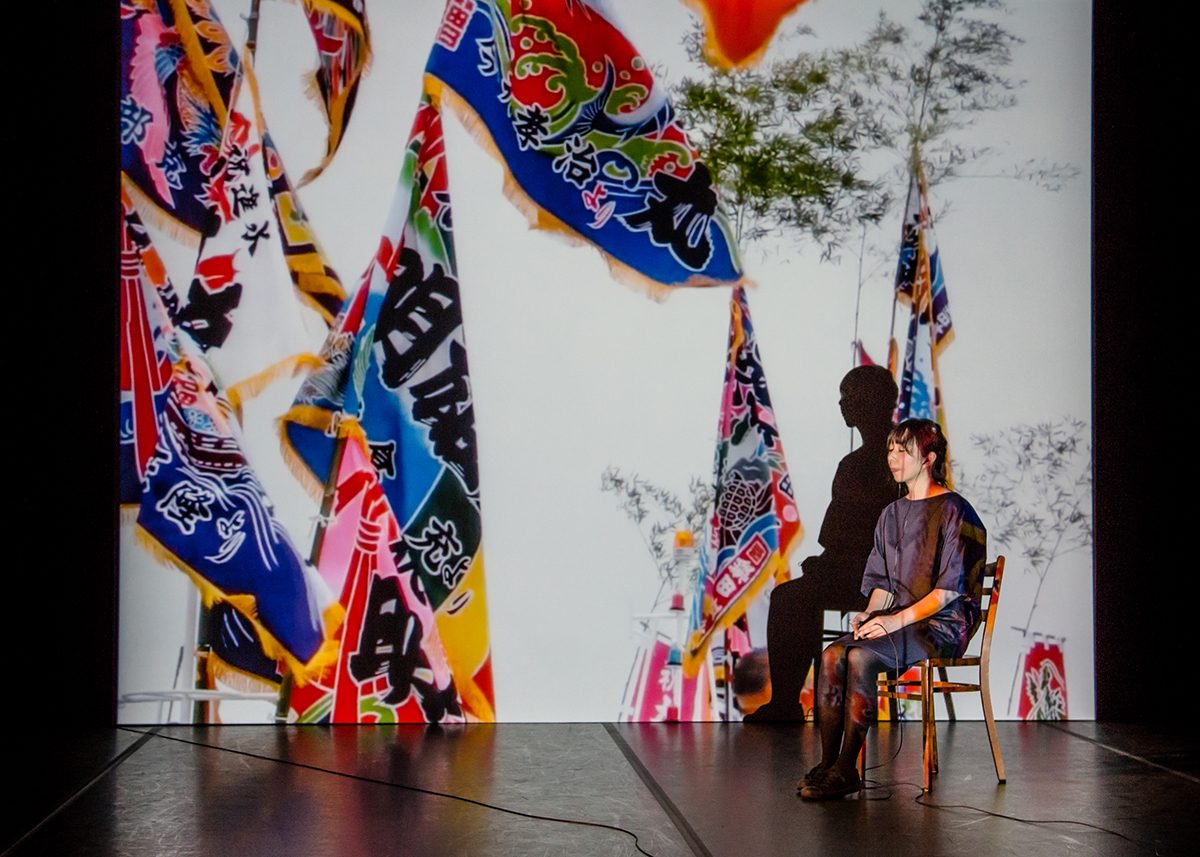Black Hole Theatre’s The Book of Revelations invites audience members into a “performance installation” that imagines the interior world of someone experiencing dementia, a character named Ada. Writer Alison Richards, in the central performance as Ada, is both the inhabitant of this world — its progenitor — and victim of its surreal alarms. It’s a world where the variegated elements of an apparently vivid personality are splitting off from each other and in the words of director Nancy Black, “as they fall, each element exists, sparkles from time to time, but the fragments don’t cohere.” As the title suggests, The Book of Revelations presents this disintegration as a series of fantastical appearances, materialising from everyday existence, alternately wondrous and terrifying.
Audience members wander around the smoke-filled set, peeking at and into arrangements of furniture, pictures, household stuff. An installation of cabinets houses a box of cutlery and one of photo slides; a set of cords dangle reading glasses and a hairbrush from the ceiling. We spot objects that must have more personal significance — a tiny fuzzy peach clings to the top of a column while a massive human-sized one lurks next to a park bench on the other side of the room. There are also peaches in the cabinets. Motifs proliferate but are distorted in shape or scale — the criss-crossed web of a rope ladder reappears in a slanted frame on the floor; doily patterns pop up here and there.
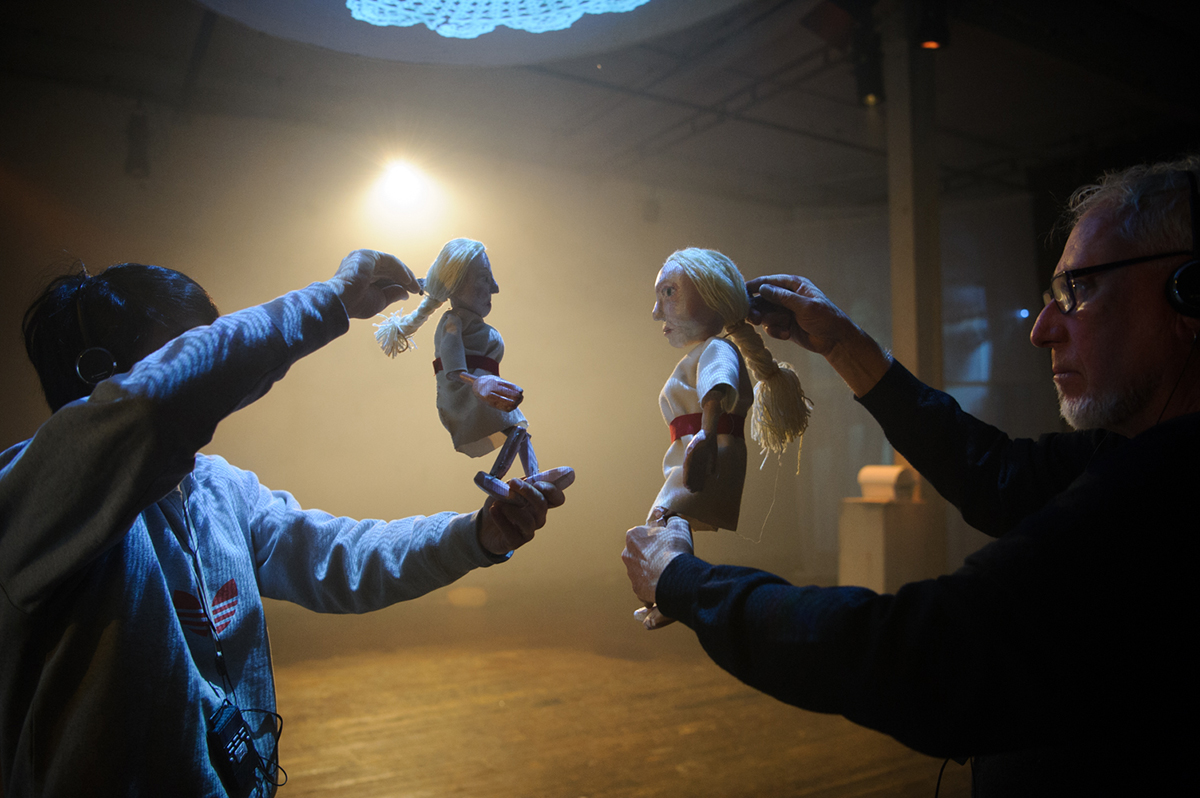
Bao Ghislain, Rod Primrose, The Book of Revelations, Black Hole Theatre, photo Sarah Walker
The repeated warping of forms gives us a sense of Ada’s fracturing perceptions. Although her world has more ‘through the looking glass’-style topsy-turvy than rawness or true horror, the production doesn’t treat the symptoms of dementia fancifully. We recognise anomia (the inability to recall words) as Ada lapses into a frustrated, “it’s on the tip of my… the tip of my….” People with dementia can also experience hyperacusis, a sensitivity to certain frequency and volume ranges of sound, making everyday noises seem unpleasantly or painfully loud. Through headsets, the audience hears ordinary sounds of daily life quickened with an hallucinatory quality and the occasional auditory shock. Bird twitters might be interrupted by the scream of a train grinding on tracks, a fly buzzes annoyingly, an opening door brings on thunder.
“He has brought me a peach from the tree in my garden, the last of summer.” The question of what is real and what is fantasy, what is happening now and what is reminiscence, what can be done and what is hopeless, constitutes Ada’s conundrum. As she moves around the space — which could variously be her immediate external world, a landscape of events from her past or in her own mind — each object she encounters has the potential to conjure a memory, or a monster. An old bed is lit from below with a childlike carousel scene; a letterbox throws out a stream of colourful images that seep and morph over Richards’ transfixed face.
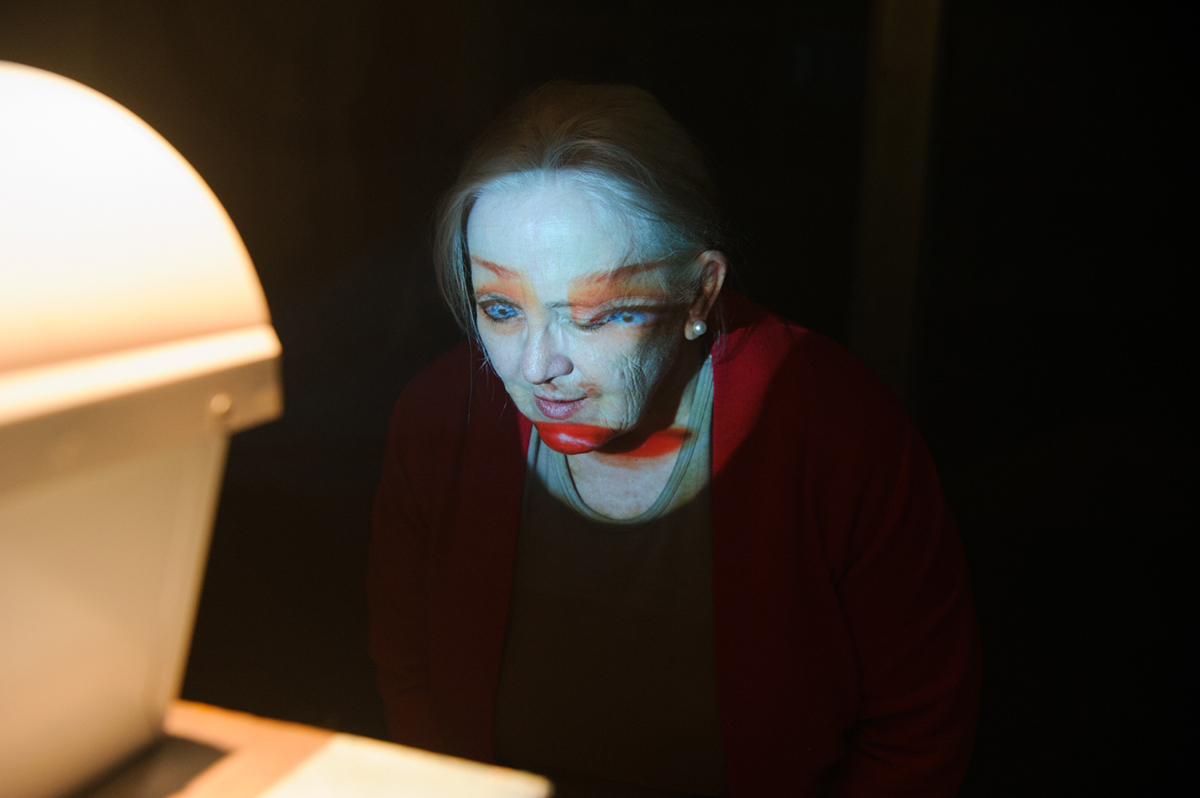
Alison Richards, The Book of Revelations, photo Sarah Walker
As Ada speaks she breaks into song, almost involuntarily (Richards is a classical singer); maybe the voice sings when speech is inaccessible, or insufficient. There is paranoia, helplessness, collapse: Ada asks, “Is this the end?” before deciding, “I’ll go on,” and then returns wearily to the Beckettian question. A chorus of disembodied voices responds: “not yet not, yet not, not yet not yet.” Richards’ interactions with audience members are mostly light-hearted and/or cheesy, but some are genuinely affecting — when, on her knees, she reaches out for help, will the woman who’s right there take her arm? And Richards’ finds unexpectedly moving words for Ada’s exhaustion: “As I turn I burn /and turning see /a thousand others burning just like me.”
The work of puppeteers Rod Primrose and Bao Ghislain makes a striking contribution to the show. Towards the end of Ada’s ordeal, a mass of glossy, claret-coloured strips of celluloid emerges from a chest and hovers upward, assuming a benign seaweedy form: is this another monster? Or an angel? When Ada eventually runs from the room, she’s refigured in the form of two miniature rod-puppets who swoop and dance, mesmerising audience members. The larger one strokes the swollen, chalky cheek of the smaller one, suggesting a nostalgic relationship between older and younger selves.
It’s a scene that epitomizes the overall impact of The Book of Revelations – the various design and production elements were inventive and gave quiet surprises, although at times I wanted a few drops of Beetlejuice surreality to darken the imagery. At times the sad, difficult aspects of dementia were movingly drawn – it must be a sad, difficult experience – but there were other revelations here too.
–
Black Hole Theatre, The Book of Revelations, writer, performer Alison Richards, director Nancy Black, composers, sound designers Faye Bendrups, David Franzke, Christine McCombe, Dagmara Gieysztor, lighting design Bronwyn Pringle, video & animation Lindsay Cox, puppet design & construction Rod Primrose, puppeteers Rod Primrose, Bao Ghislain; fortyfivedownstairs, Melbourne, 19-30 July
Top image credit: Alison Richards, The Book of Revelations, Black Hole Theatre, photo Sarah Walker
Natalie Abbott’s (re)PURPOSE: the MVMNT stages a whimsical and somewhat desultory encounter with The Dying Swan, Mikhail Fokine’s classical ballet solo from 1905. Not that this is in any sense an illustration or adaptation. Abbott is less interested in the work itself than in contesting the discourse that defines the work’s classic status.
Entering the upstairs studio at Dancehouse, we are greeted by the sound of Camille Saint-Saëns’ Le cygne, performed by Miles Brown on a theremin. Once everyone is settled, Natalie Abbott and Cheryl Cameron, both naked, appear from behind the audience and creep slowly across the stage. These may well be dying swans, of a sort: one relatively young and one relatively old. They shuffle forward, both slightly hunched, moving stiffly, keeping close to one another. Their arms waft in a parody of balletic grace.
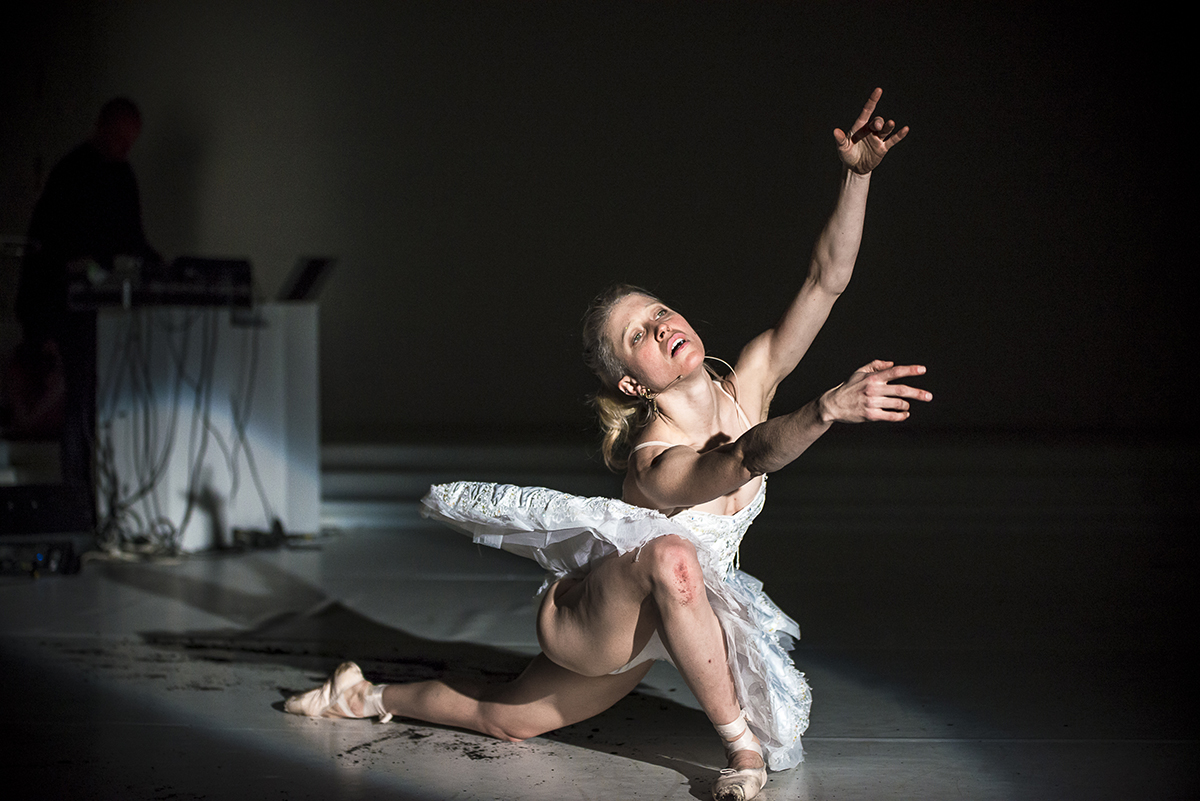
Natalie Abbott, (re)PURPOSE:the MVMNT, photo Gregory Lorenzutti
Completing their entrance, Abbott and Cameron lie face down on a sheet of silvery foil spread on one side of the stage area. The lights change to sepulchral blue and Geoffrey Watson enters through a door at the back of the stage, clomps over to the prone dancers and upends a bag of potting mix. The swans are laid to rest.
But (re)PURPOSE is less about the performance of death itself than the tragic obsession, perverse in a deep cultural sense, with the performance of death by young female dancers. Cameron and Abbott dust themselves off and read a scripted dialogue in which Abbott asks Cameron to kill her in the next scene. Cameron is not keen on this and the two argue. Cameron shouts. She knows what’s going on. She knows what’s happening. And so do we: wicked Madge or some other older woman must liquidate the heroine. This is ballet’s fairytale logic.
Like much recent independent dance in Melbourne, (re)PURPOSE is a loosely organised and thoroughly decentred work that staggers from one suggestive but half-realised performance idea to the next, revelling in dramaturgical disunity and the guilelessness of its own awkward and misconstrued but unmistakably generous invitation.
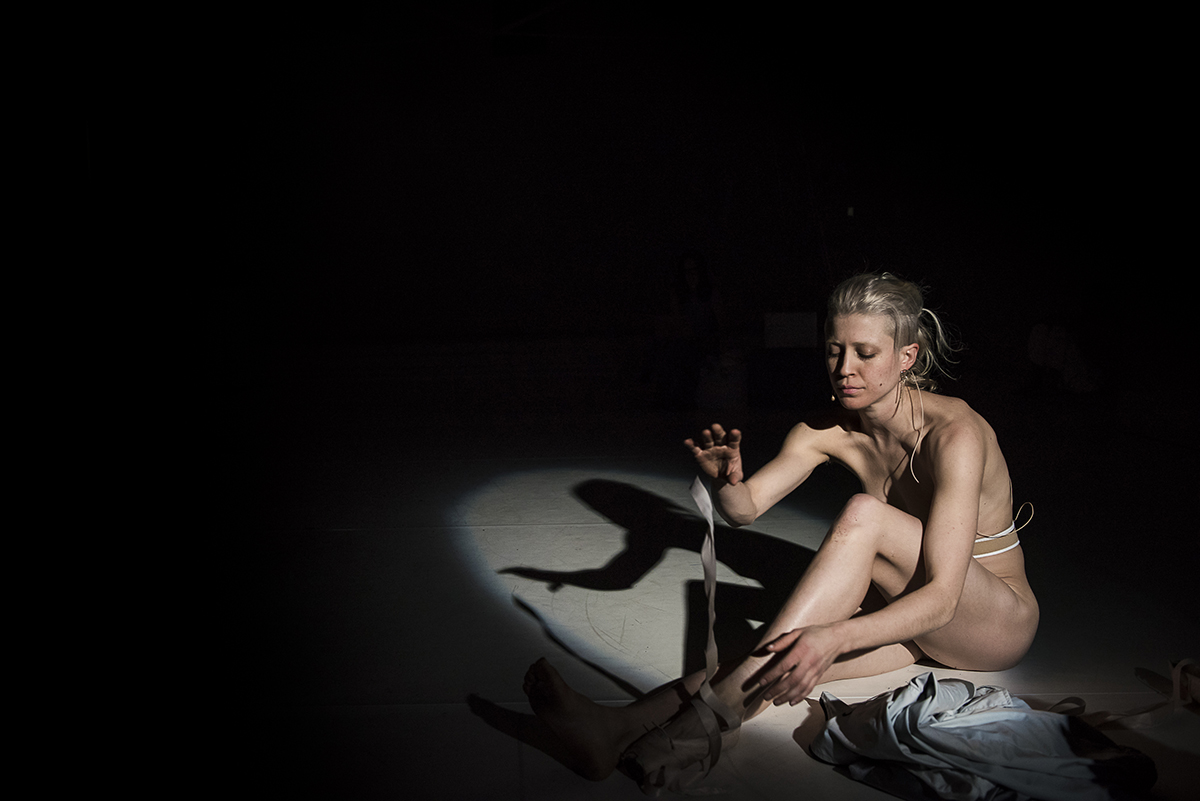
Natalie Abbott, (re)PURPOSE:the MVMNT, photo Gregory Lorenzutti
It is cheerful, but a bit complacent. We are presented with two bodies, but there is nothing immediately striking in the contrast, or in the way the two bodies are orchestrated. There is little of the rigour we saw in MAXIMUM, a work by Abbott from 2014 which examined the different physicality of a female dancer and a male bodybuilder.
It is not Fokine’s Swan that is being danced here, but we do at last catch sight of the familiar ballet, emerging briefly from behind the pile of bright ideas. Abbott climbs into a long white tutu and a pair of pointe shoes and performs a few stuttering bourrées. The lights go down and Watson takes control of a small spotlight and begins haranguing her through a bullhorn.
Yes, there are a lot of props, and a lot of different kinds of performance material, including a transcript of a phone interview with Marilyn Jones, a former principal artist and then Artistic Director of Australian Ballet. But to what end? This is choreography which aspires to the condition of critical apparatus, and yet it struggles to convey the necessary intimate knowledge of history and aesthetics and culture.
–
(re)PURPOSE: the MVMNT, choreographer, performer Natalie Abbott, performers Cheryl Cameron, Crystal Yixuan Xu, Rachael Wisby, Geoffrey Watson, dramaturg Frances Barrett, sound design Miles Brown, Alex Cuffe, lighting design Jonathan Wedgwood; Dancehouse, Melbourne, 5-9 July
Top image credit: Natalie Abbott, Cheryl Cameron, (re)PURPOSE: the MVMNT, photo Gregory Lorenzutti
“If you have the ability to create the visual language in which you’re speaking from the ground up, who can say no to that?” asks Denah Johnston, curator of Always Something There to Remind Me, a selection of 16mm experimental shorts from Canyon Cinema that recently screened at ACMI in Melbourne and Revelation Film Festival in Perth. Made by women in the US between 1958 and 2015, the technically, stylistically and thematically diverse films point to the breadth of that period’s avant-garde cinema. Out of this diversity arises Johnston’s interest in the nexus between women and representation, and together the films explore agency, social expectations and the gendered gaze.
Canyon Cinema is a collectively-run distribution company that archives independent films. It started in 1961 with informal screenings projected on a sheet hung in the backyard of the archive’s founder, filmmaker Bruce Baillie, in Canyon, California. Jack Sargeant, Program Director of Revelation, feels the new program of Canyon Cinema shorts “show the importance of the archive and of the curatorial voice, but more than this, they reveal the importance of individual filmmakers who pursue their own visions.”
Kristy Matheson, Senior Film Programmer at ACMI, echoes this motivation to bring rarely seen material to Australian screens. “In terms of a local context, I think it’s essential for female storytellers to be able to access a diverse array of works and this program did just that,” she says. “The range of storytelling devices and techniques shows a great range of work that I would hope inspires female storytellers but most importantly opens up the scope for all viewers to the ambitious and free-ranging scope of female voices.”
New cinematic languages
Johnston explains that she curated this program to highlight how women filmmakers have played with the accepted storytelling language of cinema. “There is such a vast freedom in the form. Obviously they’re not all traditional narratives with three-act structures, and I think that taking a film out of those constraints really works well for a lot of the filmmakers. To make experimental work in the first place you’re already making a conscious and aesthetic decision to step out of the narrative.”
The earliest film is Sara Kathryn Arledge’s What is a Man? (1958), started in 1951 but only completed after her release from psychiatric treatment. It’s a collection of bizarre scenes exploring gender roles, starting with Adam and Eve and moving through to modern mannequins. These are humorous, but also affective, with an emphasis on word play, like the nonsense uttered in the “psy-cry-atrist’s” office.
Sharon Couzin’s Roseblood (1974) illustrates cine-dance, centring on the performance of Carolyn Chave Kaplan. Kaplan’s hypnotic movements are interspersed with a surreal, fragmented series of symbols — flower, knife, eyes, hands. Repetition makes these everyday objects strange, and the kaleidoscopic images, dizzying pace and jarring music produce a mysterious and tense film. This is the most lyrical of the shorts, visually enthralling but also decisively and frustratingly abstruse.
Dorothy Wiley’s Miss Jesus Fries on Grill (1973) invokes a different kind of hypnotic meditation, starting with a newspaper detailing the violent death of Miss Jesus, who was thrown onto a grill when a car ploughed into a restaurant. The narrator muses over this horrifying accident as she tends to her baby, bathing, feeding and watching it fall asleep. Her actions are intimate and also palpably everyday, so different from the very unusual and public accident, and the film is immensely disquieting.
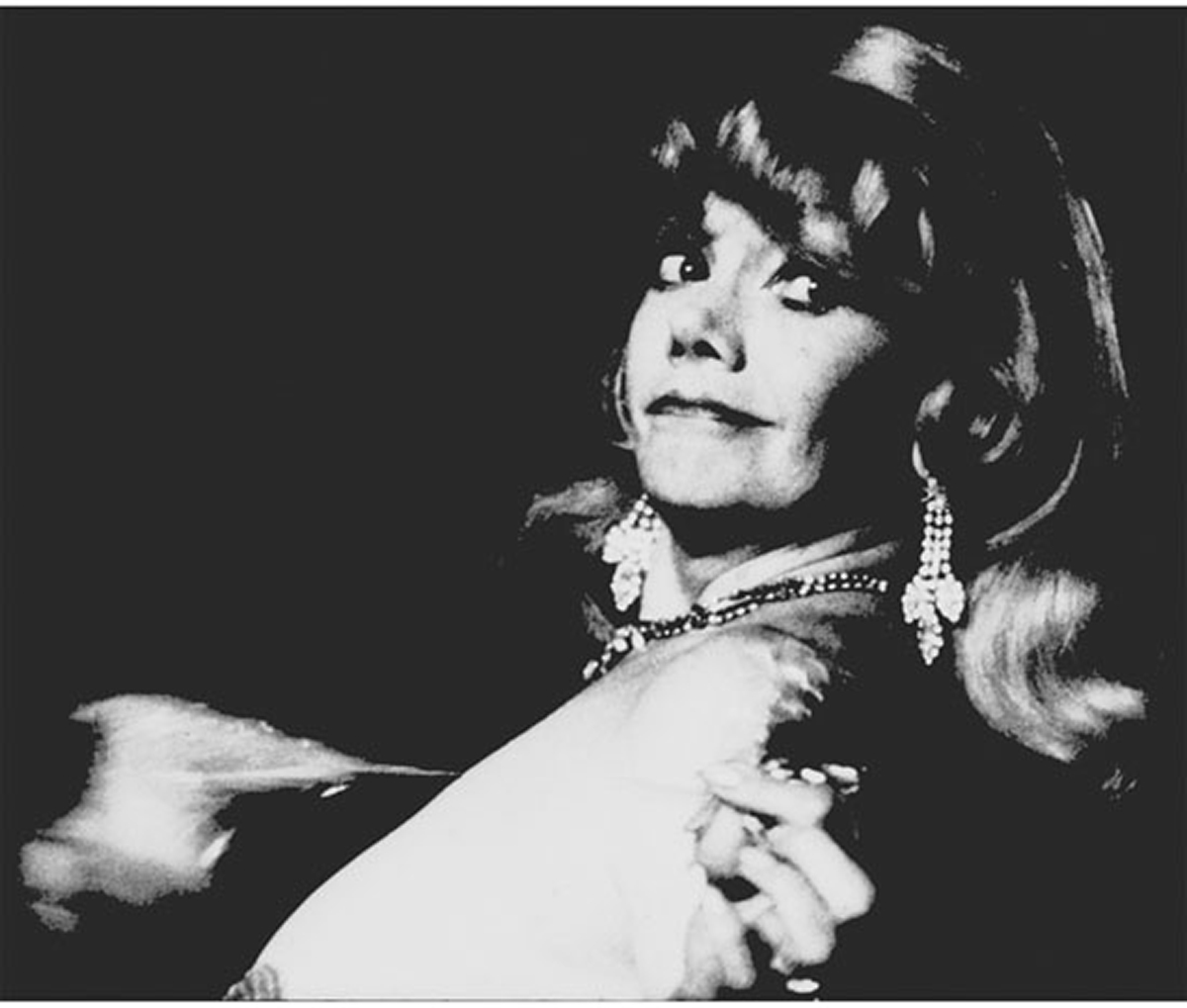
Take Off
Women, through women’s gazes
Three of the films interrogate the idea of women as objects, subverting the scopophilic gaze, a psychoanalytic theory popularised by feminist filmmaker and academic Laura Mulvey in 1976. In a defiantly radical political framework, JoAnn Elam’s Lie Back and Enjoy It (1982) aggressively questions the ways women are represented on screen by men, via a dialogue between a female and a male filmmaker. The dialectic takes priority over image here, which is mostly a flickering close-up of a woman’s face from a black and white pornographic film, distorted through looping, reversing, speed and exposure. In Removed (1999), Naomi Uman also edits a porn film, using nail polish and bleach to erase the female body. The fantasy becomes uncomfortably empty and decisively unerotic. Uman’s film comments on female performativity, in porn and in society, reflecting how identity is manufactured through societal conventions. This is echoed in Gunvor Nelson’s Take Off (1972), which also subverts the male gaze and conventional representations of women. She documents Ellion Ness, a famous burlesque performer, as she stages a striptease, which is conventional until she finishes undressing. When the act should be over, she continues the process in what becomes a surreal disassembling of her body. Ness reduces herself to her parts, as revealed to her expectant audience, but is gleefully in control as she discards the layers.
Chronicles of a Lying Spirit (by Kelly Gabron) (1992), directed by Cauleen Smith, also explores the fabrication of identity, specifically through the lens of her experience as a black woman. An example of Afrofuturism, the film layers time, space and history in following the imagined life of Smith’s alter-ego Kelly Gabron. There is a dual-narration from Gabron and a male voice discussing her in the third person, and the entire story is repeated, prompting a consideration of the instability and unreliability of history.
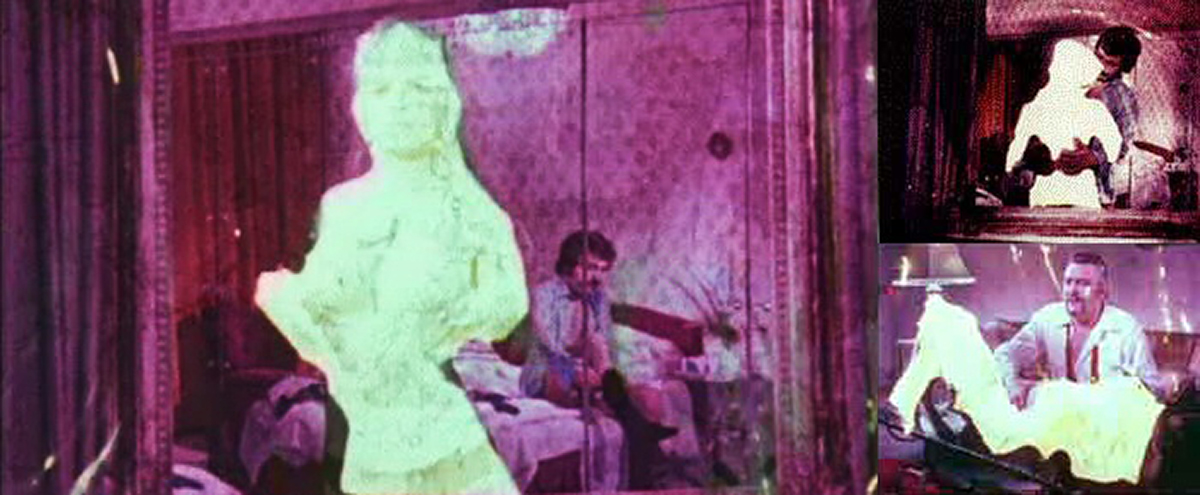
Removed
Collaborative context
Many of the works were collaboratively made and led to further collective activities. Kate McCabe founded the art collective Kidnap Yourself in the town of Joshua Tree, where she discovered inspiration and a creative community. The apocalyptically themed You and I Remain (2015), by McCabe and the collective, is part of the ACMI program. The filmmaker has remarked elsewhere that “you will find more females here behind the camera directing than in the commercial film world and that’s one of the many reasons that field [of experimental film] is vibrant and lush with ideas. The filmmakers I love from the 60s and 70s were breaking new ground.”
JoAnn Elam was also a founding member of Filmgroup (now Chicago Filmmakers) in 1973, which still holds weekly screenings of experimental work. Also in Chicago, Couzin cofounded the Experimental Film Coalition, of which she was president from 1983 to 1988. Some artists collaborated with friends, notably Nelson and Wiley, who made their award-winning first film Schmeerguntz together in 1965, with Nelson revealing that “Dorothy and I needed each other to dare to do it!”
The works are all shaped by socio-cultural discourse and social and professional opportunities offered by second wave feminism, and Johnston draws a comparison between the political consciousness of women filmmakers in the 1970s and today, saying, “right now, I feel like it’s on.”

You and I Remain
Local parallels
Tracing these films, there emerge parallels in Australian cinema history, where there was a surge of women filmmakers in the 1970s. Significantly, there was structural support for this, including the Women’s Film Fund (1975-1990), the Experimental Film Fund (1970-1978) and the Sydney Filmmakers Cooperative (1970-1986). There were also collectives like the Sydney Women’s Film Group (1971) and the splinter group Feminist Film Workers (1978) and events like the International Women’s Film Festival (1975).
If much of this government funding has ceased, or at least changed significantly, there continues to be critical — and importantly, public — interest in women filmmakers, with film festivals now providing the backbone of structural support. There are dedicated festivals like For Film’s Sake and Stranger With My Face Festival, which provides mentorship for women developing genre features, while OtherFilm has held several exhibitions and festivals of avant-garde work in Brisbane and at Gertrude Contemporary in Melbourne. Jack Sargeant notes, “this isn’t to say that there shouldn’t be more spaces, more funding or whatever, but there are people making and exhibiting works, so, while the situation could always be improved, I don’t see it as entirely bleak either.”
–
Always Something There to Remind Me, Canyon Cinema retrospective, curator, Denah Johnston, presented by ACMI and Revelation Film Festival, ACMI, Melbourne, 5 July; Perth, 9-18 July
Kate Robertson is a cultural critic with a PhD in Art History & Film Studies, and has written about arts and culture for The Atlantic, Vice, Marie Claire, i-D, Junkee, Overland, 4:3 and Senses of Cinema.
Top image credit: Chronicles of a Lying Spirit
There’s an air of mystery and wonder about the work of Christian Thompson. What is it that makes this protean artist and his obsession with self-portraiture such an enduring fascination? We are told that he is exploring the construction of a sense of self, and the play of race, gender, nationality, sexuality and the rest. But what does this really mean? After all, there is no subject that is more conventional than exploring the concept of identity. It is the ‘nature morte’ of the 21st century. What is it that distinguishes Thompson’s work?
Now we have a new survey exhibition curated by Charlotte Day and Hetti Perkins at the Monash University Museum of Art (MUMA), an opportunity to trace Thompson’s shifting approach to questions of ipseity and alterity across more than 15 years of work, and to admire the parade of fantastical caricatures and Indigenous dreams and queer heroes.
It’s a timely exhibition — broad though not comprehensive — as Thompson was recently named as the inaugural recipient of ACMI’s Mordant Family VR commission, worth $80,000. This current survey includes photographic, video, sculptural and audio works; so it is interesting to think that he will soon be working in the hybrid medium of virtual reality technologies. Is there some submerged connection between Thompson’s interest in the movement between identity categories and spaces and the use of multiple art forms?
The exhibition is called Ritual Intimacies, a title which suggests — rather seductively — that Thompson’s real medium is and has always been performance. It’s an invitation to read individual works as a kind of documentation or material trace of some more ephemeral ceremony of self-becoming. This appeal to the performative is obviously part of a broader trend in international contemporary practice, but it does give a neat effect of formal cohesion and focus to this show; and through this optic Thompson’s approach seems somehow less eclectic or quixotic than it might otherwise.
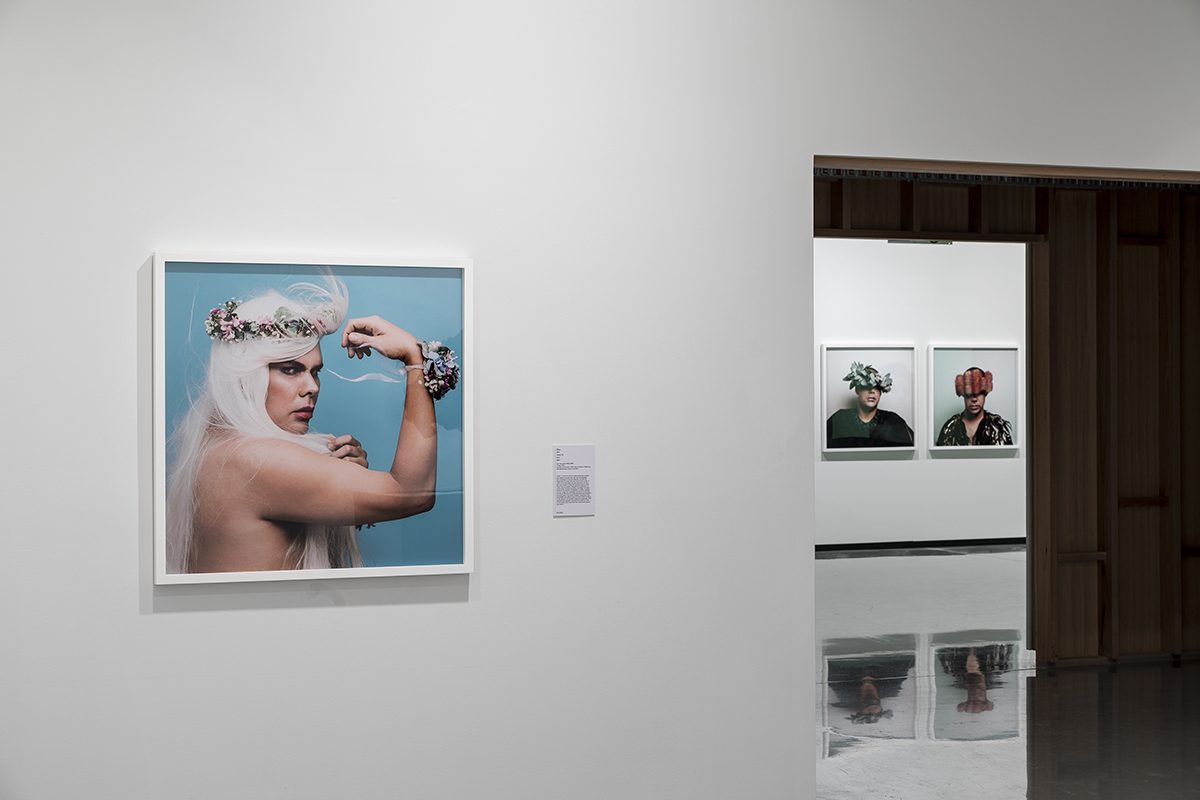
Christian Thompson: Ritual Intimacy, installation view: Monash University Museum of Art, Melbourne, 2017, photo Andrew Curtis
Of course, there are works which already have a documentary aesthetic. For instance, the earliest piece in this exhibition, Kangaroo and boomerang jumper, a machine-knit jumper with extremely long sleeves from the Blaks Palace (2002) series, is presented here in a museum vitrine and with an untitled picture of Marcia Langton wearing the jumper on the opposite wall.
The survey includes the Australian Graffiti (2007) series, the last body of work that Thompson completed before leaving Australia. This work still stands out as a unique aesthetic achievement; but here it resonates in new and interesting ways. Ritual Intimacies includes seven of the “untitled” pictures from that sequence. Each is a head-and-shoulders portrait of Thompson dressed in clothes recalling the New Romantic phase of flamboyant clothing. Around his head, and always partially covering his eyes, he wears a garland of native flora.
When they were first exhibited, these images suggested a sort of distortion or a natural ‘graffito’ of the face, an interruption transforming the body into landscape. In the present context, however, the images seem also to participate in a rite of personal mythmaking. The floral ornaments start to look like sacred headdresses or the paraphernalia of a private cult; the fierce eyes staring out from the shadows, behind the bright flowers, are like those of a zealous new initiate.
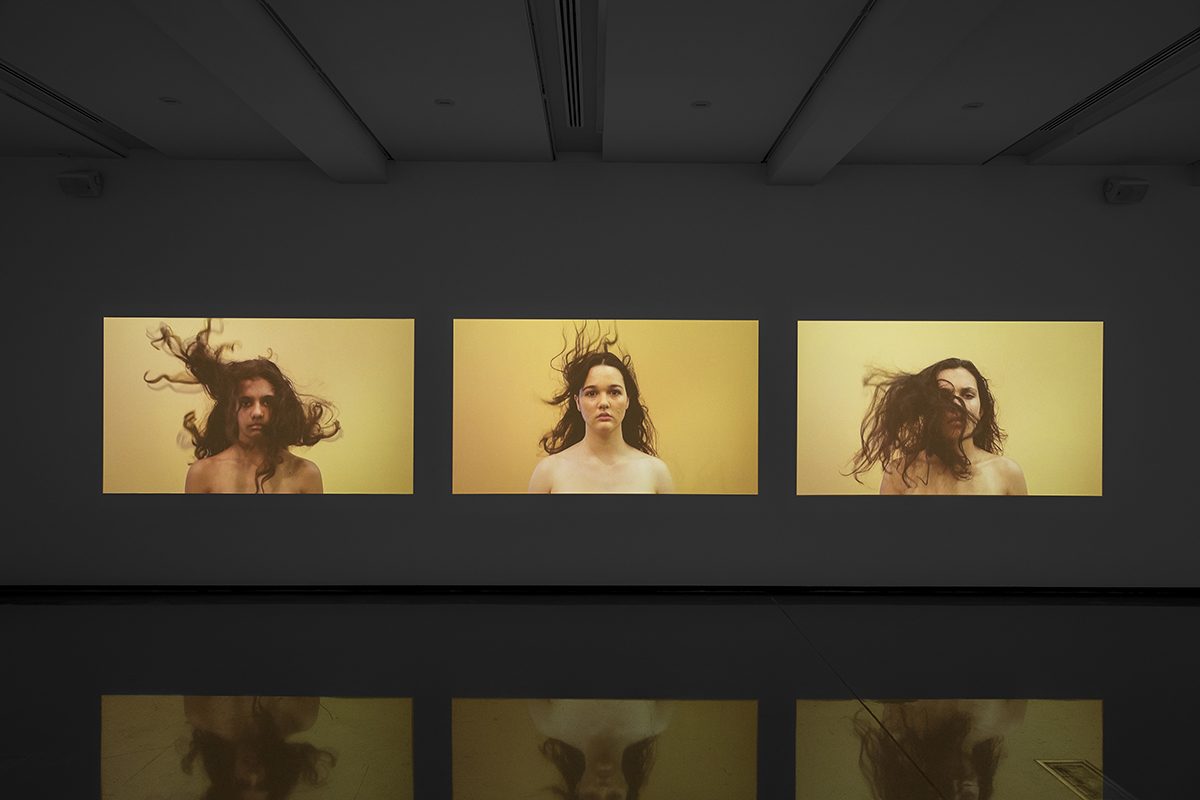
Christian Thompson: Ritual intimacy, installation view: Monash University Museum of Art, Melbourne 2017, photo: Andrew Curtis
Another standout piece is Heat, a short three-channel video work from 2010. It features three young women, each on a separate screen and looking down the camera while from below, like heat rising off the ground, a gentle breeze slowly wafts their hair. Like so many of the videos and photographs in this exhibition the framing is head-and-shoulders and the women are bare-shouldered. It’s an outwardly simple work, with its plain orangey background, but compositionally compelling with a strong savour of the sensual, and the memory of sun on skin.
Thompson’s handling of the tension between simplicity of form and complexity of surface and texture is typically effortless. My favourite pieces in this exhibition are Trinity I-III from the Polari (2014) series. Again these are head-and-shoulders portraits of Thompson in character. Here he is made-up in uncanny drag, hunched, hulking and dominating the pictorial space. A thick column of marijuana smoke unspools from his open mouth, mingling with the tousled strands of a long ashy-blonde wig. These are pictures full of rhythmic and textural interest: between the reddened lips and the reddened eyelids; between the white face paint and the white pyramidal pile of flowers sitting on top of the wig; and between the smoky background and the rubbed white body paint, with Thompson’s darker skin showing through.
Thompson has said that he tends to construct his photographs in the way that he would make a sculpture, emphasising the materiality of the figure and surface. This strong sense of three-dimensional presence is something that the Polari series shares with the well-known Billy King (2010) series, of which seven pictures are included in this exhibition: those luridly patterned hoodies with beaded necklaces cascading out of the hoods. Looking at the two groups together it’s impossible not to feel an echo between those massed beads and the massed flowers.
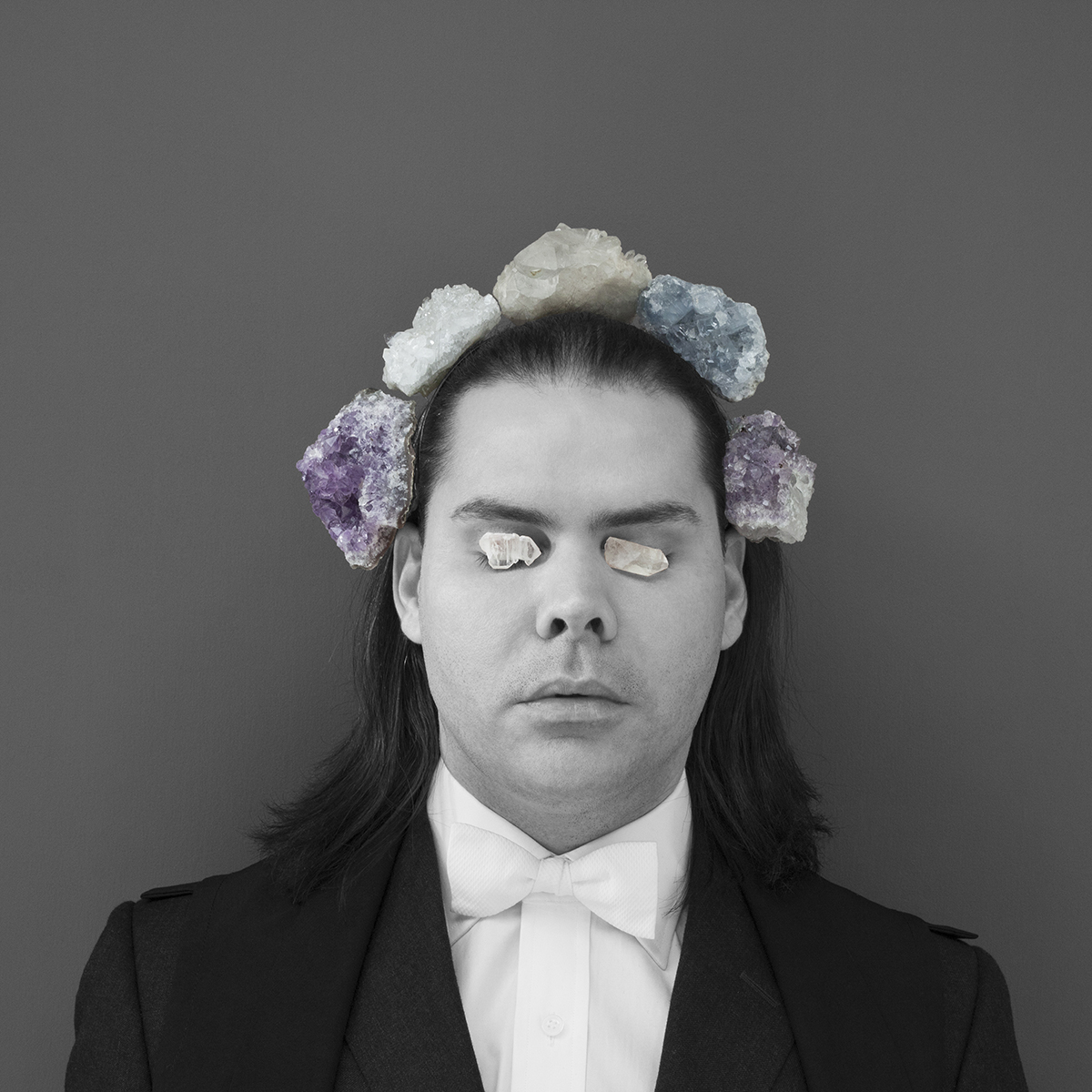
Down Under World from the series We bury our own, 2012, courtesy of the artist, Sarah Scout Presents, Melbourne and Michael Reid, Sydney and Berlin
Pitt Rivers Museum
In 2010, Thompson was one of two students to accept the inaugural Charlie Perkins Trust Scholarship to attend Oxford University. As part of the creative component of his doctorate, Thompson staged an artistic intervention in the Pitt Rivers Museum collection. Pitt Rivers is one of colonialism’s more visible archives, an ethnographic collection second in size only to the British Museum. And, of course, it features a large amount of Aboriginal Australian material.
The result of this intervention is We bury our own (2012). It’s a strange series, which has been widely exhibited (in the dining room at Trinity College, Oxford, among other venues) and is the problematic centre of the current survey. For me, this series recalls something Hal Foster once suggested about the figure of the artist-as-archivist: the way that they are often less interested in critiques of cultural representation and institutional integrity, and more interested in perpetuating or legislating existing archival practices. And I can’t help wondering if Thompson’s collaboration with Pitt Rivers archives might be a missed opportunity for a more substantial interrogation of the efforts of museums with major collections in ethnography and anthropology to sidestep demands for immediate decolonisation.
Thompson describes the process he developed for creating this series as “spiritual repatriation,” proposing a psychical departure from the archive into contemporary creative practice. His methodology is to meditate on the photographs and artefacts in the collection in order to release their spirit in his imagination; and in this way, something intangible but real in these objects is returned to the world.
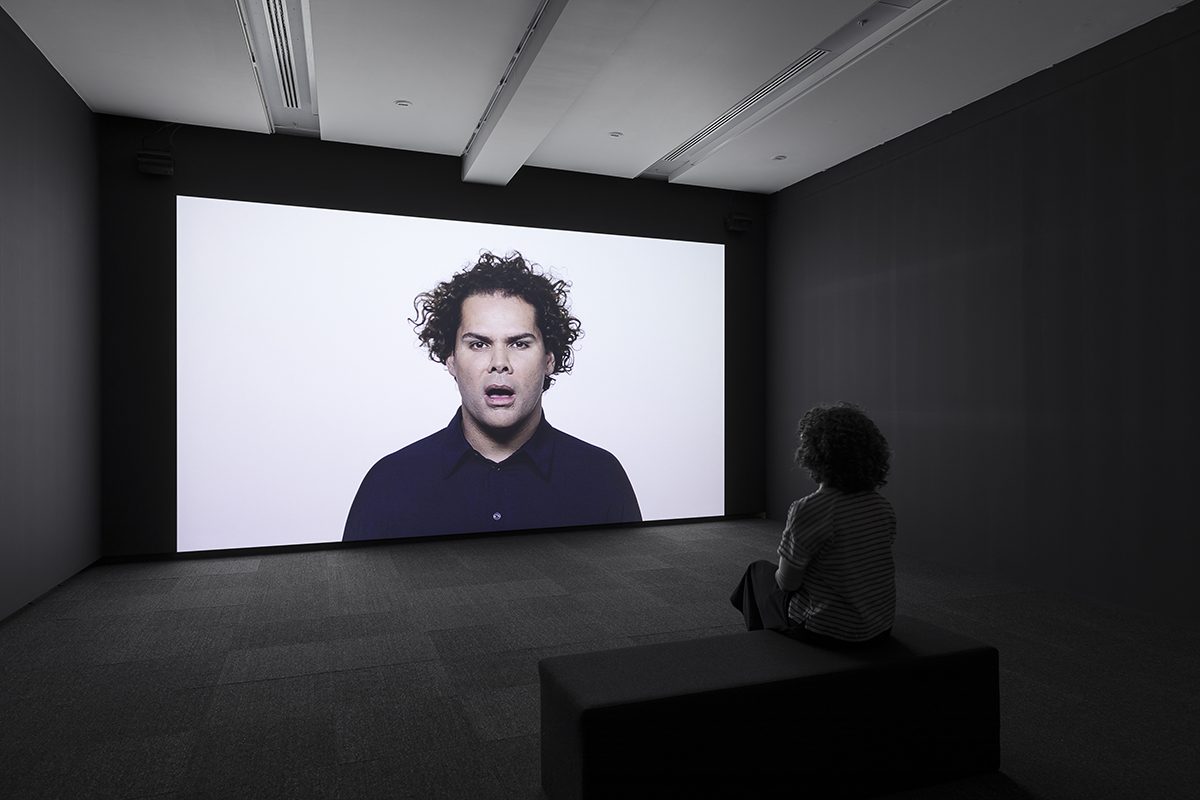
Christian Thompson: Ritual intimacy, installation view: Monash University Museum of Art, Melbourne 2017, photo: Andrew Curtis
Certainly, this can be read positively in the broader context of attempts by marginalised communities to rewrite cultural histories distorted by colonial intervention. Christopher Morton, the curator of Photograph and Manuscript Collections at Pitt Rivers, suggests that Thompson’s engagement with the collection will help change the archive in terms of its foundational colonial assumptions, but it would be interesting to know precisely how that might happen.
In short: is this really a meaningful contribution to the cultural restitution debate? In an enthusiastic and provocative catalogue essay, British novelist Marina Warner writes:
“Could such acts of spiritual repatriation become a way of letting regimes and institutions, such as colleges and museums, off the hook? […] The question remains unanswered, perhaps unanswerable, as the success of an artist’s claim to spiritually repatriate an object or image must remain subjective.”
Well, partly subjective, but never entirely. There are always shared perspectives and one can advocate for the effectiveness of the art object in itself, something that Warner does not do.
For me, Thompson’s Pitt Rivers pictures — black-and-white self-portraits digitally overlaid with brightly coloured bits and pieces such as crystals and candles and butterflies — are an unexpected visual weak point in this survey. There’s little of that absolute sureness of figure-composition that one can usually rely on with Thompson; the faces are blocked by the awkward placement of the votary objects and his body always seems pasted to the background. They are closed-up and incommunicative, images without breath or movement, and a rare failure of Christian Thompson’s instinct for enchantment.
The Museum of Others (2016) is a follow-up series to We bury our own, and a re-evaluation of Thompson’s engagement with the Pitt Rivers collection. This sequence of doubled portraits features the artist holding placards with likenesses of famous (or infamous) Englishmen such as James Cook, John Ruskin and Augustus Pitt Rivers in front of his own face. Their eyes have been cut out and through the holes we see Thompson’s own eyes peering out, deep in shadow.
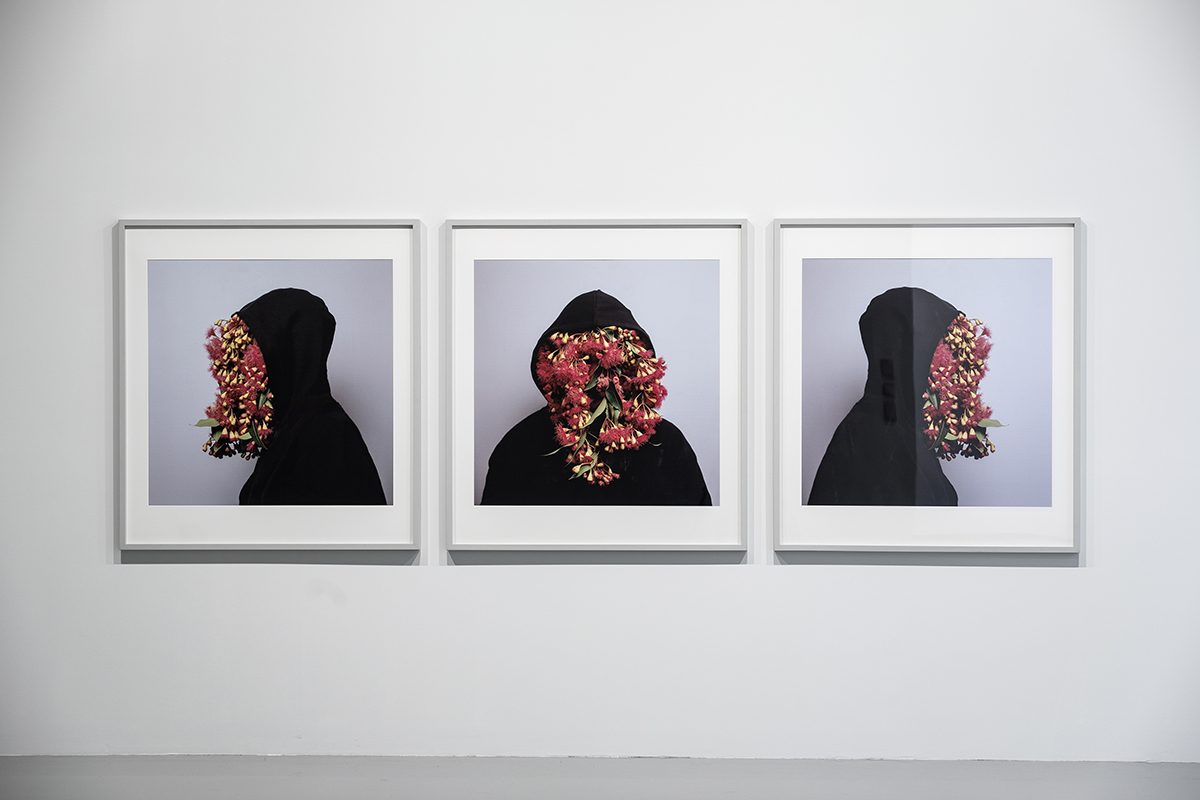
Christian Thompson: Ritual Intimacy, installation view: Monash University Museum of Art, Melbourne, 2017, photo Andrew Curtis
Thompson himself explains these pictures in terms of “othering” the Western gaze, but it’s also possible to read them as the acknowledgement of a certain form of capture, as though Christian Thompson, by engaging with the Pitt Rivers Museum were somehow masked or effaced by these personalities, the ideologies they represent and the history of cultural, political and economic entanglements linking colonialism, liberalism and globalisation. As bold as these pictures are, they look rather malevolent, as if the old lords were suddenly reanimated.
But the masks do come off. This is one of the consistently surprising things about Thompson’s practice: that shudder of excitement when he steps out from behind the exotic persona. The newest work featured in this exhibition is Berceuse (2017), a lullaby sung by Thompson in Bidjara and recorded as a three-channel video. It’s a kind of companion to Refuge (2014), also included in the exhibition, another video piece in which Thompson sings in language. In both of these works he presents himself to camera without any costume frippery or flirtiness, without apparent irony or paradox. It is in these moments that the mystery of Thompson’s attraction seems most explicable, pointing to the fundamental honesty which grounds his practice; such a simple thing, and yet the rarest quality in contemporary art.
Finally, speaking of words, it’s worth noting that one of the most rewarding features of Ritual Intimacies is the chance to observe the way Bidjara language has steadily moved toward the centre of Christian Thompson’s practice over the years.
See co-curator Hetti Perkins interview Christian Thompson below:
–
Christian Thompson, Ritual Intimacy, curators Charlotte Day, Hetti Perkins, MUMA, Monash University, Melbourne, 27 April-8 July
Top image credit: Desert melon from the series We bury our own, 2012, Monash University Collection, purchased by the Faculty of Science 2015


